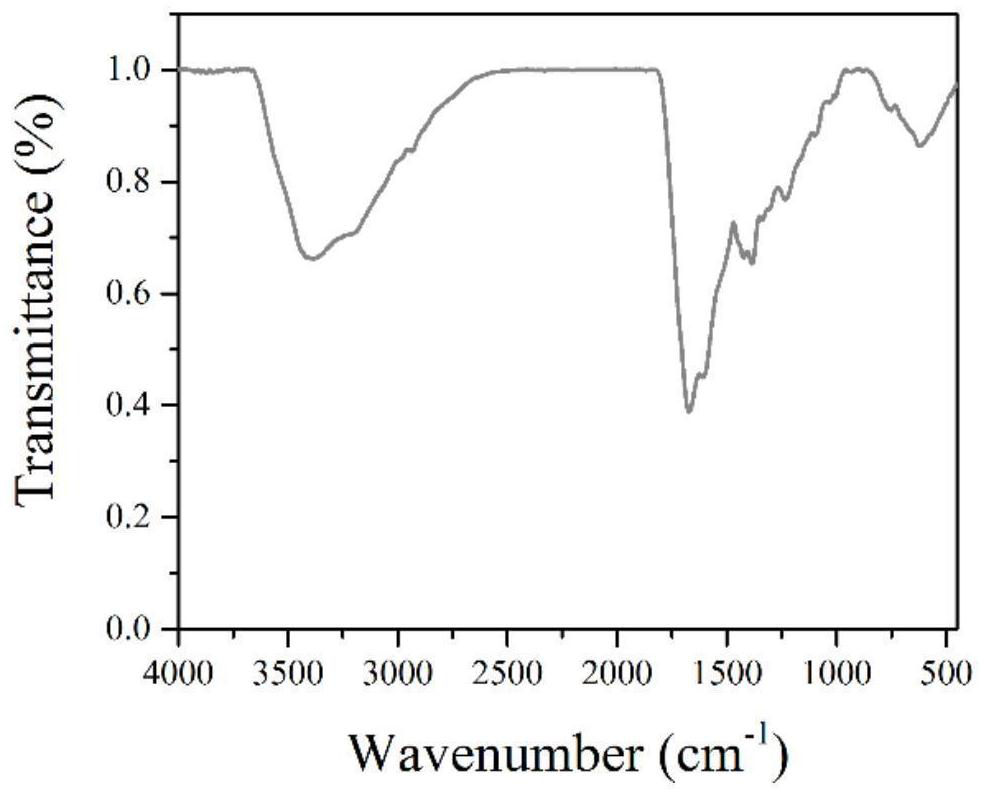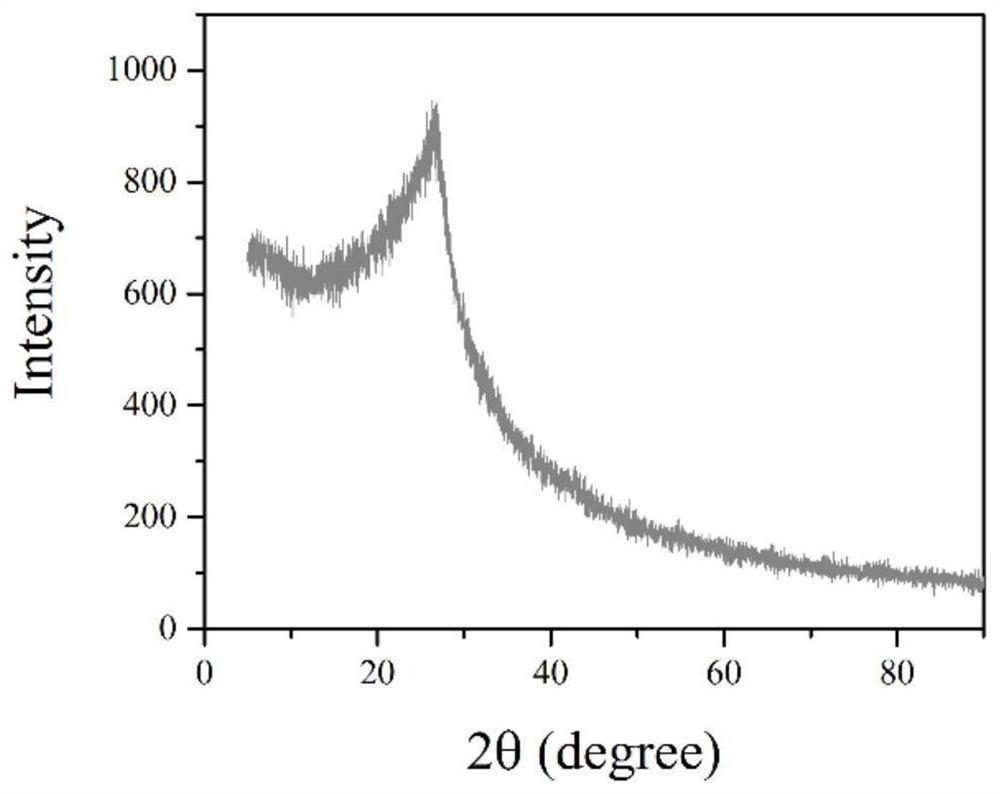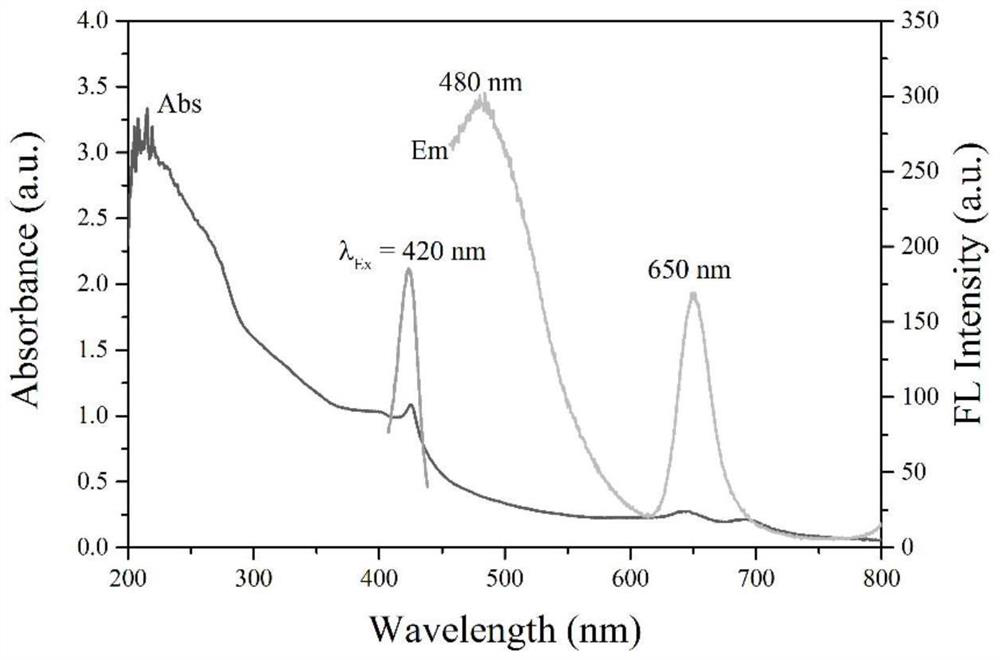Dual-emission-ratio fluorescent carbon dots as well as preparation method and application thereof
A ratiometric fluorescence and dual-emission technology, applied in luminescent materials, fluorescence/phosphorescence, chemical instruments and methods, etc., can solve the problems of high cost, complicated operation and processing, and time-consuming
- Summary
- Abstract
- Description
- Claims
- Application Information
AI Technical Summary
Problems solved by technology
Method used
Image
Examples
Embodiment 1
[0037] One for the detection of Fe3+ The preparation method of the dual-emission ratio fluorescent carbon dot comprises the steps:
[0038] Weigh 30 g of sodium alginate and 1 g of glutathione and dissolve them in 150 mL of deionized water, stir magnetically at room temperature for 30 min to completely dissolve the solids, and transfer the resulting mixed system to a microwave synthesizer with a polytetrafluoroethylene liner , heated to 100°C at a heating rate of 4°C / min, and reacted for 24 hours. After the reaction stopped, the program dropped to room temperature, and then the product obtained was vacuum filtered through a 0.22 μm filter membrane, and the obtained filtrate was dialyzed with a 3500Da dialysis bag for 120 hours, and collected The dialysate is finally freeze-dried to obtain dual-emission ratio fluorescent carbon dots. The absolute fluorescence quantum yield of the prepared dual-emission ratio fluorescent carbon dots was measured by a fluorescence spectrometer, a...
Embodiment 2
[0040] One for the detection of Fe 3+ The preparation method of the dual-emission ratio fluorescent carbon dot comprises the steps:
[0041] Weigh 1g of sodium alginate and 30g of glutathione and dissolve them in 200mL of DMF, stir magnetically at room temperature for 5min to completely dissolve the solids, transfer the resulting mixed system to a microwave synthesizer with a polytetrafluoroethylene liner, Heat to 220°C at a heating rate of 20°C / min, and react for 0.5h. After the reaction stops, the program lowers to room temperature, and then the product obtained is vacuum filtered through a 0.22μm filter membrane. The dialysate is finally freeze-dried to obtain dual-emission ratio fluorescent carbon dots. The absolute fluorescence quantum yield of the prepared dual-emission ratio fluorescent carbon dots was measured by a fluorescence spectrometer, and the fluorescence quantum yield was 6.8%.
Embodiment 3
[0043] One for the detection of Fe 3+ The preparation method of the dual-emission ratio fluorescent carbon dot comprises the steps:
[0044] Dissolve 10 g of sodium alginate and 10 g of glutathione in a mixed solution of 200 mL of deionized water / DMF (volume ratio 3 / 1), stir magnetically at room temperature for 10 min to completely dissolve the solid, and transfer the resulting mixed system to Put it into a microwave synthesizer with a polytetrafluoroethylene liner, heat it up to 190°C at a heating rate of 10°C / min, and react for 8 hours. After the reaction stops, the program will drop to room temperature, and then vacuum filter the obtained product through a 0.22 μm filter. Dialyze the resulting filtrate with a 3500Da dialysis bag for 90 hours, collect the dialysate, and finally freeze-dry to obtain the dual-emission ratio fluorescent carbon dots. The absolute fluorescence quantum yield of the prepared dual-emission ratio fluorescent carbon dots was measured by a fluorescenc...
PUM
 Login to View More
Login to View More Abstract
Description
Claims
Application Information
 Login to View More
Login to View More - R&D
- Intellectual Property
- Life Sciences
- Materials
- Tech Scout
- Unparalleled Data Quality
- Higher Quality Content
- 60% Fewer Hallucinations
Browse by: Latest US Patents, China's latest patents, Technical Efficacy Thesaurus, Application Domain, Technology Topic, Popular Technical Reports.
© 2025 PatSnap. All rights reserved.Legal|Privacy policy|Modern Slavery Act Transparency Statement|Sitemap|About US| Contact US: help@patsnap.com



